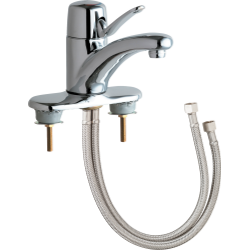Single Handle Lavatory Faucet: Single Handle Lavatory Bathroom Faucet

A single handle lavatory faucet is a popular choice for bathroom sinks, offering convenience and style in a compact design. It features a single lever that controls both hot and cold water flow, allowing for easy temperature adjustment with a simple turn.
Components of a Single Handle Lavatory Faucet
The primary components of a single handle lavatory faucet include:
- Handle: The lever that controls water flow and temperature.
- Spout: The outlet where water flows from the faucet.
- Cartridge: The internal mechanism that mixes hot and cold water and regulates flow.
- Base: The mounting plate that secures the faucet to the sink.
- Aerator: A small device at the spout’s end that mixes air with water, creating a smooth and even flow.
Functionality of a Single Handle Lavatory Faucet
The single handle design allows for effortless control of water temperature and flow. By turning the handle clockwise, you increase hot water flow, while turning it counter-clockwise increases cold water flow. The cartridge inside the faucet mixes the hot and cold water, delivering the desired temperature to the spout.
Advantages of Using a Single Handle Lavatory Faucet
- Ease of Use: The single lever design makes it simple to adjust water temperature and flow with one hand.
- Space-Saving: The compact design takes up less space on the countertop compared to two-handle faucets.
- Modern Aesthetics: Single handle faucets often have sleek and contemporary designs that complement modern bathroom decor.
- Improved Temperature Control: The cartridge system allows for precise temperature adjustment, reducing the risk of scalding.
Disadvantages of Using a Single Handle Lavatory Faucet
- Potential for Cartridge Failure: The cartridge is a crucial component, and if it fails, the entire faucet may need replacement.
- Limited Styling Options: While single handle faucets offer modern aesthetics, they may have fewer styling options compared to two-handle faucets.
Comparison of Single Handle Faucets with Other Types
- Two-Handle Faucets: Two-handle faucets feature separate handles for hot and cold water control. They offer more flexibility in temperature adjustment but require two hands to operate and take up more counter space.
- Widespread Faucets: Widespread faucets have separate hot and cold water spouts positioned farther apart than centerset faucets. They provide a more contemporary look but require larger sink holes and more space on the countertop.
Installation and Maintenance of Single Handle Lavatory Faucets

Installing and maintaining a single-handle lavatory faucet is a straightforward process that can be accomplished with basic tools and a little bit of know-how. This guide provides a step-by-step approach to installing a single-handle lavatory faucet, troubleshooting common problems, and establishing a routine for regular maintenance.
Installation of Single Handle Lavatory Faucets
Installing a single-handle lavatory faucet is a relatively simple process that can be done by most homeowners with basic plumbing skills.
- Gather the necessary tools and materials. This includes a wrench, pliers, adjustable wrench, pipe thread tape, plumber’s putty, and a screwdriver.
- Turn off the water supply. Locate the shut-off valves for the hot and cold water lines and turn them off.
- Disconnect the old faucet. Unscrew the nuts that hold the old faucet to the sink and remove the old faucet.
- Clean the sink and faucet base. Use a cleaning cloth to remove any dirt or debris from the sink and faucet base.
- Install the new faucet base. Apply plumber’s putty to the base of the new faucet and carefully place it on the sink. Tighten the nuts that hold the base to the sink, making sure not to overtighten.
- Connect the water lines. Attach the water lines to the faucet base and tighten the connections with a wrench. Make sure the hot and cold water lines are connected to the correct ports.
- Turn on the water supply. Turn on the shut-off valves for the hot and cold water lines and check for any leaks.
- Test the faucet. Run the water through the faucet to check for any leaks or problems.
Troubleshooting Common Problems, Single handle lavatory bathroom faucet
Single-handle faucets are generally reliable, but some common problems may arise.
- Leaking Faucet: A leaking faucet can be caused by a worn-out cartridge, loose connections, or a damaged O-ring.
- Low Water Pressure: Low water pressure can be caused by a clogged aerator, a partially closed shut-off valve, or a buildup of mineral deposits in the faucet.
- Faucet Handle Does Not Move Smoothly: This issue can be caused by a worn-out cartridge, a buildup of mineral deposits, or a damaged handle.
- Faucet Handle Sticks or Feels Stiff: This can be caused by a buildup of mineral deposits, a worn-out cartridge, or a damaged handle.
Regular Maintenance Checklist
Regular maintenance can help prevent problems and extend the life of your single-handle lavatory faucet.
- Clean the faucet regularly. Use a soft cloth and a mild cleaning solution to wipe down the faucet and remove any dirt or debris.
- Clean the aerator. Remove the aerator from the faucet spout and clean it with a toothbrush and a mild cleaning solution.
- Lubricate the cartridge. If your faucet uses a cartridge, it’s a good idea to lubricate it with a silicone-based lubricant.
- Replace the cartridge. Over time, the cartridge in your faucet may wear out and need to be replaced.
